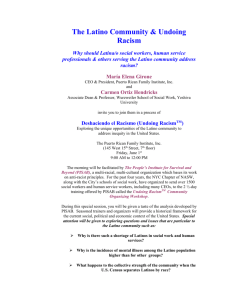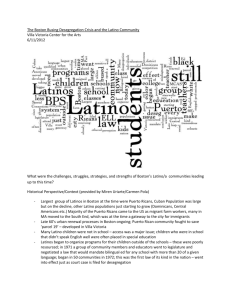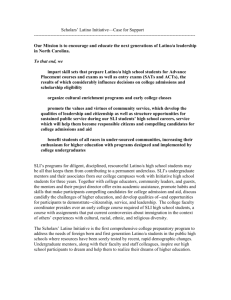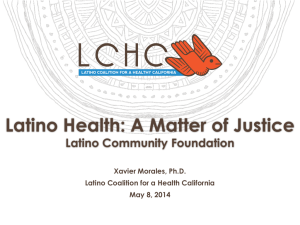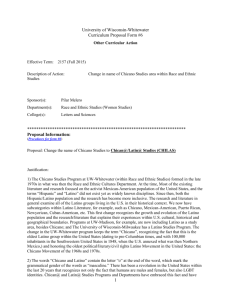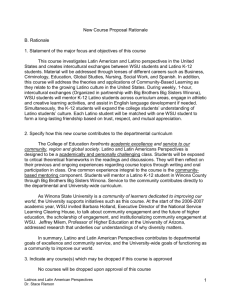Winter 2013 - Chicano/Latino Studies
advertisement
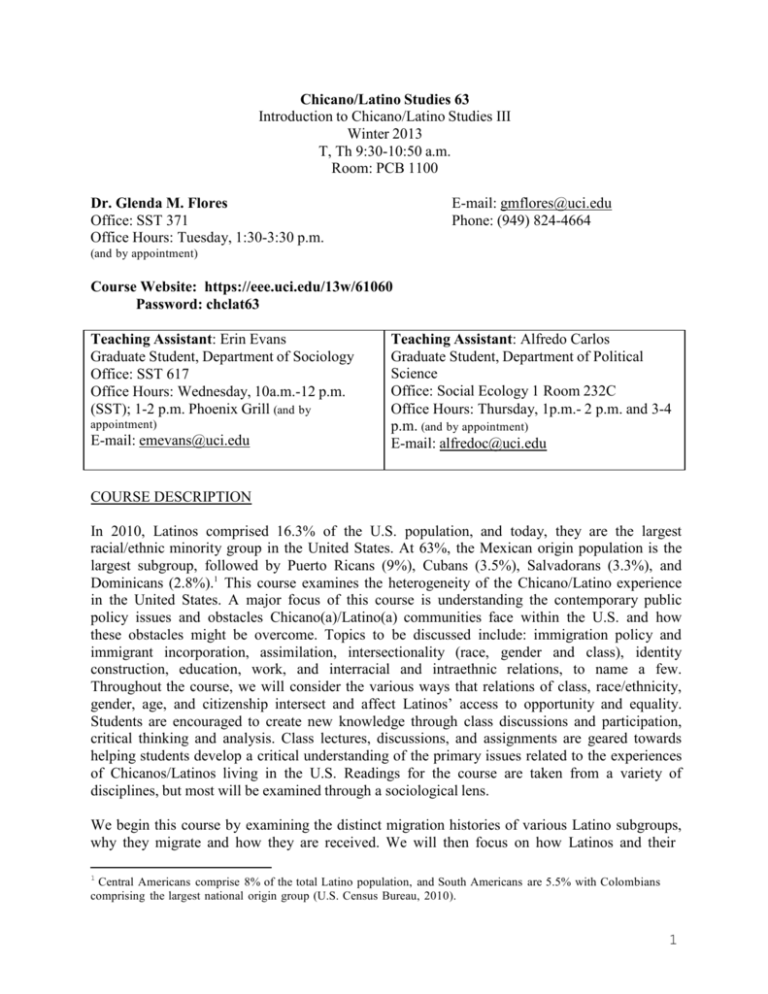
Chicano/Latino Studies 63 Introduction to Chicano/Latino Studies III Winter 2013 T, Th 9:30-10:50 a.m. Room: PCB 1100 Dr. Glenda M. Flores Office: SST 371 Office Hours: Tuesday, 1:30-3:30 p.m. E-mail: gmflores@uci.edu Phone: (949) 824-4664 (and by appointment) Course Website: https://eee.uci.edu/13w/61060 Password: chclat63 Teaching Assistant: Erin Evans Graduate Student, Department of Sociology Office: SST 617 Office Hours: Wednesday, 10a.m.-12 p.m. (SST); 1-2 p.m. Phoenix Grill (and by appointment) E-mail: emevans@uci.edu Teaching Assistant: Alfredo Carlos Graduate Student, Department of Political Science Office: Social Ecology 1 Room 232C Office Hours: Thursday, 1p.m.- 2 p.m. and 3-4 p.m. (and by appointment) E-mail: alfredoc@uci.edu COURSE DESCRIPTION In 2010, Latinos comprised 16.3% of the U.S. population, and today, they are the largest racial/ethnic minority group in the United States. At 63%, the Mexican origin population is the largest subgroup, followed by Puerto Ricans (9%), Cubans (3.5%), Salvadorans (3.3%), and Dominicans (2.8%).1 This course examines the heterogeneity of the Chicano/Latino experience in the United States. A major focus of this course is understanding the contemporary public policy issues and obstacles Chicano(a)/Latino(a) communities face within the U.S. and how these obstacles might be overcome. Topics to be discussed include: immigration policy and immigrant incorporation, assimilation, intersectionality (race, gender and class), identity construction, education, work, and interracial and intraethnic relations, to name a few. Throughout the course, we will consider the various ways that relations of class, race/ethnicity, gender, age, and citizenship intersect and affect Latinos’ access to opportunity and equality. Students are encouraged to create new knowledge through class discussions and participation, critical thinking and analysis. Class lectures, discussions, and assignments are geared towards helping students develop a critical understanding of the primary issues related to the experiences of Chicanos/Latinos living in the U.S. Readings for the course are taken from a variety of disciplines, but most will be examined through a sociological lens. We begin this course by examining the distinct migration histories of various Latino subgroups, why they migrate and how they are received. We will then focus on how Latinos and their 1 Central Americans comprise 8% of the total Latino population, and South Americans are 5.5% with Colombians comprising the largest national origin group (U.S. Census Bureau, 2010). 1 descendants are incorporating into the United States’ core social structures. We conclude with an examination of new and emergent color lines as Latinos have transformed the United States from a largely black-white society to one now consisting of multiple racial/ethnic groups. This course meets the core course requirement for the undergraduate major and minor in the Department of Chicano/Latino Studies. This course also meets the University’s General Education requirement for “Social and Behavioral Sciences” (Category III) and “Multicultural Studies” (Category VII). The readings and discussion in this course will allow us to make comparisons by nationality, generation, and citizenship across and within Latinas/os in the U.S., including Mexicans, Central Americans and Caribbean subgroups. REQUIRED TEXTS: 1. Lopez, Nancy. 2003. Hopeful Girls, Troubled Boys: Race and Gender Disparity in Urban Education. New York: Routledge. 2. Menjivar, Cecilia. 2000. Fragmented Ties: Salvadoran Immigrant Networks in America. Berkeley and Los Angeles, California: University of California Press. 3. Readings posted online* (These readings are marked with an *) OPTIONAL TEXT: Hondagneu-Sotelo, Pierrette. 2001. Domestica: Immigrant Workers Cleaning and Caring in the Shadows of Affluence. Berkeley and Los Angeles, California: University of California Press. COURSE REQUIREMENTS and EVALUATION OF PROJECTS 1. LECTURE PARTICIPATION and ATTENDANCE (10%) This class is based on active student participation in class discussions. You are expected to attend every class meeting prepared to discuss the assigned reading. Attendance and inclass participation account for 10% of your grade. This includes active and informed in-class participation that demonstrates a thoughtful reading of the course material. It is your responsibility to read all course materials prior to class. Attendance will be taken within the first 30 minutes of class. It is your responsibility to make sure you sign the roll sheet. Do not sign the roll sheet for your classmates. Do not overlook the importance of participation and attendance in calculating your grade. This grade is based on the number of class meetings you attend and will increase or decrease depending on your active participation or behavior in class. Things that will bring down your grade are disruptive behavior; disrespect towards your professor, TA’s, or peers; comments that reveal a lack of preparation, sleeping in class; excessive tardiness, excessive absences, and web surfing. Excessive absences and constant disruptive behavior will result in a failing class participation grade. Do not assume that you will receive full participation and credit merely for showing up to class. You must also thoughtfully participate in lecture discussions. 2. IN CLASS ESSAYS (10%) Each Tuesday (starting 1/22) there will be a brief essay assignment to ascertain how well you are engaged in the course (attending lectures and reading assignments). These are open book and open note. The assignment will start at the beginning of class so if you are late you will 2 lose time and may not be able to complete the assignment. The essay topic will come from a central theme from the previous week’s reading and course discussions and will be an opportunity for you to reflect on the material. These assignments are graded credit/no credit and cannot be made up under any circumstance. However, you can miss two essays without penalty. If you are prepared each day it is possible that you will earn extra credit, since there will be 7 essays, each worth 2% of your overall grade; you therefore have the opportunity to earn 4 additional percentage points. Do not assume that simply filling a page will earn you credit; your writing must reflect awareness of central issues and ideas expressed by authors and in class. 3. MIDTERM AND FINAL EXAMS (2 at 50% total) There will be two exams throughout the course of the semester, a midterm and a final exam taken in class. These exams will consist of multiple choice, short answer and essay questions. Exams will draw from readings, class lectures, guest lectures, discussion section, on campus lectures that I may ask you to attend, and any film or video clips shown in class. If you will miss a class, please make sure to obtain notes from a classmate. The final exam will be cumulative. 4. DISCUSSION SECTION ATTENDANCE & PARTICIPATION (10%) Attendance at and active participation in discussion section is mandatory and accounts for 10% of your grade. Your TA will take attendance and determine your section score. 5. CRITICAL ANALYSIS PAPER (20%) You have three available options to satisfy this component of the class. Option A: Relationship Between Immigration, Social Networks, Intersectionality Doméstica is one of the foundational texts in the field of Latino sociology. Read Pierrette Hondagneu-Sotelo’s, Domestica: Immigrant Workers Cleaning and Caring in the Shadows of Affluence (listed as an optional text) in its entirety. How does she describe the importance of social networks and intersectionality in the lives of the Mexican and Central American domestic workers she interviewed and observed? How do her findings compare with Cecilia Menjivar’s discussion of social networks and immigration in Fragmented Ties? Discuss what these authors teach us about the relationship between immigration, social networks, context of reception and intersectionality in a 5-7 page paper; due February 21. Specific instructions for this paper will be posted on Blackboard. Option B: Literary Text Analysis This version of the critical analysis paper consists of an analysis of a literary text. This means that you must select a literary text (a possible list is included at the end of the this syllabus) to read and complete 1 essay (max 5-7 pages) on this text. Your essay should analyze this book through a Chicano/Latino studies lens by using theories, empirical evidence and concepts discussed in class. You must correctly apply a minimum of 5 theories/concepts and 4 scholarly sources used in class. Papers will be graded based on their originality and how well concepts and theories are integrated and analyzed. The list of books is located on the last page of this syllabus. Option B is due March 14. Specific instructions for this paper will be posted on Blackboard. 3 Option C: Comparative Analysis Although we covered the migration trajectories and incorporation patterns of many Latino subgroups from different regions, we were unable to cover all of them in detail. This critical analysis paper requires that you compare and contrast the migration trajectory, immigration policies, and incorporation patterns of two Latino subgroups, one of which was not covered extensively in class (ex. Puerto Ricans, Peruvians, Hondurans, Colombians etc.). You must compare their migration trajectory to another Latino group discussed in class and assess how they are incorporating into 3 aspects of the core U.S. social structures (ex. education, gender dynamics, the workplace, racial hierarchy etc.) You must use at least 3 external academic sources (preferably peer reviewed journal articles) concerning the Latino group of your choice to complete 1 comparative essay (max 5-7 pages). You must also correctly apply a minimum of 6 theories/concepts and 2 scholarly sources used in class. Option C is also due March 14. Specific instructions for this paper will be posted on Blackboard. 6. GRADING All of the materials outlined in this syllabus are required. Students are expected to use all of the information available to make points, arguments and critical assessments in your assignments and course discussions. Grading will be as follows: Lecture Attendance & Participation Tuesday lecture in-class essays Discussion section attendance & participation Critical Analysis Paper -Option A (February 21) -Option B/C (March 14) In class midterm (February 12) In class final exam (March 21) RUBRIC 100%-97%=A+ 96%-93%=A 92%-90%=A- 89%-87%=B+ 86%-83%=B 82%-81%=B- 10% 10% 10% 20% 25% 25% 100% 79%-77%=C+ 76%-73%=C 72%-70%=C- 69%-67%=D+ 66%-63%=D 62%-60%=D- CLASS POLICIES As with any class, students should behave in a professional and respectful manner. Below are the class policies. 1. Arrive on time. 2. Cell phones should be turned completely off. If you use a computer, it should be employed for taking course notes only. In other words, Facebooking, tweeting and email checking are not allowed. Repeated incidents of Facebooking or email will result in a low attendance/participation grade as it is distracting to other students and disrespectful to the professor. 4 3. 4. Talking with other students during class and other disruptive behavior will not be tolerated—it is disrespectful to your classmates and the Professor, and detracts from our goal of mastering the course material. Respect others’ opinions and comments. The Professor will work to make sure that all students enjoy a distraction-free, civil and supportive environment in which to learn and express ideas—this means listening to others’ ideas and addressing them respectfully. ACADEMIC INTEGRITY Academic honesty is fundamental to the activities and principles of a university and this class. The professor is required to uphold and enforce the rules against cheating, dishonest conduct, plagiarism and collusion (working secretly in groups). Students who submit work that is not entirely their own will be subject to the University’s academic dishonesty policies. The guide for avoiding plagiarism can be found here: http://www.editor.uci.edu/11-12/appx/appx.2.htm. Please read the guide so that you are aware of what counts as academic honesty and plagiarism, and or/ask your TA or the Professor for clarification. COMMUNICATION It is the student’s responsibility to frequently check their e-mail and the class website for any class communications. Please put “ChcLat 63” in the subject line of e-mail messages. Do not contact your TA or the Professor with last minute questions about exams and assignments or other matters relating to the class. Such matters should be resolved during your sections or office hours. We will not answer substantive questions via e-mail. Keep in mind that your Professor and TA are quite busy and probably cannot check e-mail as often as you may. Absolutely no assignments will be accepted via e-mail. We will be using the course website (eee.uci.edu) to post announcements, most handouts and course articles, so check this site periodically. DROP BOX You must upload your critical analysis paper via dropbox on eee.uci.edu, which will generate an originality report to guard against plagiarism. A hard copy should also be time-stamped and placed in your TA’s mailbox before the due date and time; alternatively, you may bring a hard copy of the assignment to class on the due date. Both of these conditions must be met in order to receive a grade. Assignments that arrive late will not be graded. All papers must be uploaded and submitted by 4:00 p.m. on their due date. Extra credit opportunities may arise at times; note that special individual opportunities for extra credit violate university policy and will not be considered. Finally, grades are earned, they are not given. Nitpicking over points is discouraged, as it reveals a commitment to a grade rather than to learning. **Any special learning needs should be brought to our attention as soon as possible** Note: This syllabus may be slightly modified throughout the course of the quarter. 5 SCHEDULE OF READINGS Week 1: Introduction to the Course and Theories of Migration January 8, January 10 (1/8) Introduction to the Course (1/10) *Massey, Douglas, Durand, Jorge and Malone, Nolan. 2002. “Principles of Operation: Theories of International Migration” Pp. 7-23 in Beyond Smoke and Mirrors: Mexican Immigration in an Era of Economic Integration. New York: Russell Sage. Menjivar, Cecilia. 2000. Fragmented Ties: Salvadoran Immigrant Networks in America. Berkeley and Los Angeles, California: University of California Press. (Introduction pgs. 1-15 and Chapter 1) Weekly Topic(s): We address issues of internal heterogeneity within the Latino population and why they migrate to the United States. Week 2: Divergent Migration Pathways: Why do Latinos move? January 15, January 17 (1/15) *Massey, Douglas, Durand, Jorge and Malone, Nolan. 2002. “System Assembly: A History of Mexico-U.S. Migration” Pp. 24-51, in Beyond Smoke and Mirrors: Mexican Immigration in an Era of Economic Integration. New York: Russell Sage. Menjivar, Cecilia. 2000. Fragmented Ties: Salvadoran Immigrant Networks in America. Berkeley and Los Angeles, California: University of California Press. (Chapters 2 & 3) (1/17) Movie: Crossing Arizona Weekly Topic(s): How is the migration experience/immigrant narrative different for Latino subgroups? What are the macro-level and micro-level forces that propel migration? What are some differences in the reasons for migration, the type of migration patterns and settlement between groups? Week 3: Context of Reception and Social Networks January 22, January 24 (1/22) (First In Class Essay) **Short piece on Cubans in Miami** (posted to website) (1/24) Menjivar, Cecilia. 2000. Fragmented Ties: Salvadoran Immigrant Networks in America. Berkeley and Los Angeles, California: University of California Press. (Chapter 4 & 5) 6 Hondagneu-Sotelo, Pierrette. 2001. Domestica: Immigrant Workers Cleaning and Caring in the Shadows of Affluence. Berkeley and Los Angeles, California: University of California Press. (Chapter 3) Weekly Topic(s): We examine how are various Latino subgroups are received in the United States and the social networks that are available to them. What are the policies of the sending and receiving countries? Week 4: Immigrant Incorporation, Assimilation and Segmented Assimilation January 29, 31 (1/29) *Portes, Alejandro and Min Zhou. 1993. “The New Second Generation: Segmented Assimilation and its Variants.” Annals of the American Academy of Political and Social Science, 530: 74-96. http://ann.sagepub.com/cgi/content/short/530/1/74 (1/31) Lopez, Nancy. 2002. Hopeful Girls, Troubled Boys: Race and Gender Disparity in Urban Education. Routledge. (Chapter 1) *Gonzales, Roberto G. 2011. “Learning to be Illegal: Undocumented Youth and Shifting Legal Contexts in the Transition to Adulthood” American Sociological Review 76: 602-619. Weekly Topic(s): We hypothesize what segment of society today’s Latino immigrants are incorporating into based on their race/ethnic backgrounds, gender, class and citizenship status. Week 5: Latino Incorporation: Race, Gender, Class and Citizenship February 5, February 7 (2/5) *Estrada, Emir. 2012. “Changing Household Dynamics: Children’s American Generational Resources in Street Vending Markets.” Childhood. Lopez, Nancy. 2002. Hopeful Girls, Troubled Boys: Race and Gender Disparity in Urban Education. Routledge. (Chapter 6) (2/7) *Agius Vallejo, Jody and Lee, Jennifer. 2009. “Brown Picket Fences: The Immigrant Narrative and Patterns of Giving Back among the Mexican Origin Middle-Class in Los Angeles.” Ethnicities, 9: 5-23. Weekly Topic(s): We continue to examine the role of intersectionality on incorporation and mobility patterns. What is the role of age, gender, race and socioeconomic class to Latino incorporation? Week 6: Midterm February 12, February 14 7 February 12-Midterm February 14-TBA (“Fear and Learning at Hoover Elementary”) Week 7: Latinos and Education February 19, February 21 (2/19) Lopez, Nancy. 2002. Hopeful Girls, Troubled Boys: Race and Gender Disparity in Urban Education. Routledge. (Chapter 3). *Gonzalez, Gilbert. 1990. “Culture, Language and the Americanization of Mexican Children” Pp. 30-45 in Chicano Education in the Era of Segregation. Philadelphia: The Balch Institute Press. (2/21) Option A Paper Due *Flores, Glenda. 2012. The Hidden Chicana/Latina Cultural Pedagogy in Schools” (Under review at Sociology of Education) <Please do not distribute without the professor’s permission> Weekly Topic(s): What are some of the unique obstacles that Latinos face in educational institutions? Is the Spanish language a threat to English dominance? Week 8: Intergenerational Dynamics, Bicultural Conflicts, and the Workplace February 26, 28 *Valenzuela, Abel. 1999. “Gender Roles and Settlement Activities Among Children and Their Immigrant Families.” American Behavioral Scientist, 42: 720-42. Menjivar, C. (2000). Fragmented Ties: Salvadoran Immigrant Networks in America. Berkeley, CA: University of California Press. (Chapter 7). Lopez, Nancy. 2003. Hopeful Girls, Troubled Boys: Race and Gender Disparity in Urban Education. Routledge. (Chapter 7) Weekly Topic(s): We examine intergenerational conflicts that may emerge between immigrant parents and their U.S. born/acculturated children. Week 9: Racial/Ethnic Identities March 5, March 7 (3/5) *Duany, Jorge. 1998. “Reconstructing Racial Identity: Ethnicity, Color and Class Among Dominicans in the U.S. and Puerto Rico.” Latin American Perspectives 100: 147-172. (3/7) 8 Lopez, Nancy. 2003. Hopeful Girls, Troubled Boys: Race and Gender Disparity in Urban Education. New York: Routledge. (Chapter 4 & 5) Weekly Topic(s): What is the difference between imposed and self-identification? How do Latinos self-identify? What factors can influence how Latinos self-identify within a Latino subgroup? Week 10: Intra-ethnic and Interracial Relations in the U.S. March 12, March 14 (3/12) *Stuesse, Angela. 2009. “Race, Migration, and Labor Control: Neoliberal Challenges to Organizing Mississippi's Poultry Workers.” In Latino Immigrants and the Transformation of the U.S. South. M. Odem and E. Lacy, eds. Pp. 91-111. Athens, GA: University of Georgia Press. (3/14) Option B & C Paper Due Movie: Mylene Moreno’s, Recalling Orange County (2005) Weekly Topic(s): What are some of the sources of tension within Latino subgroups and between racial/ethnic groups? The American South has a long tradition of the black/white binary, what issues are emerging as a result of Latino immigration? Finals Week: *Thursday, March 21, 2013 (IN CLASS FINAL EXAM) 8:00 a.m.-10:00 a.m. CRITICAL ANALYSIS PAPER: POSSIBLE BOOK REPORT LIST Below is a list of possible books you can choose from. I have tried to locate books that focus on different Latino subgroups. If there is a book not on this list that you would like to read, please consult with me beforehand. Enriquez’s Journey by Sonia Nazario Finding Mañana by Mirtha Ojito How the Garcia Girls Lost Their Accents by Julia Alvarez Always Running by Luis Rodriguez Down These Mean Streets by Piri Thomas Two Badges: The Lives of Mona Ruiz by Mona Ruiz and Geoff Boucher The House on Mango Street by Sandra Cisneros Bless Me Ultima by Rudolfo Anaya Dreaming in Cuban by Cristina Garcia When I was Puerto Rican by Esmeralda Santiago Rain of Gold by Victor Villasenor The Moths and Other Stories by Helena Maria Viramontes Into the Beautiful North by Luis Alberto Urrea Just Like Us: The True Story of Four Mexican Girls Coming of Age in America by Helen Thorpe 9



